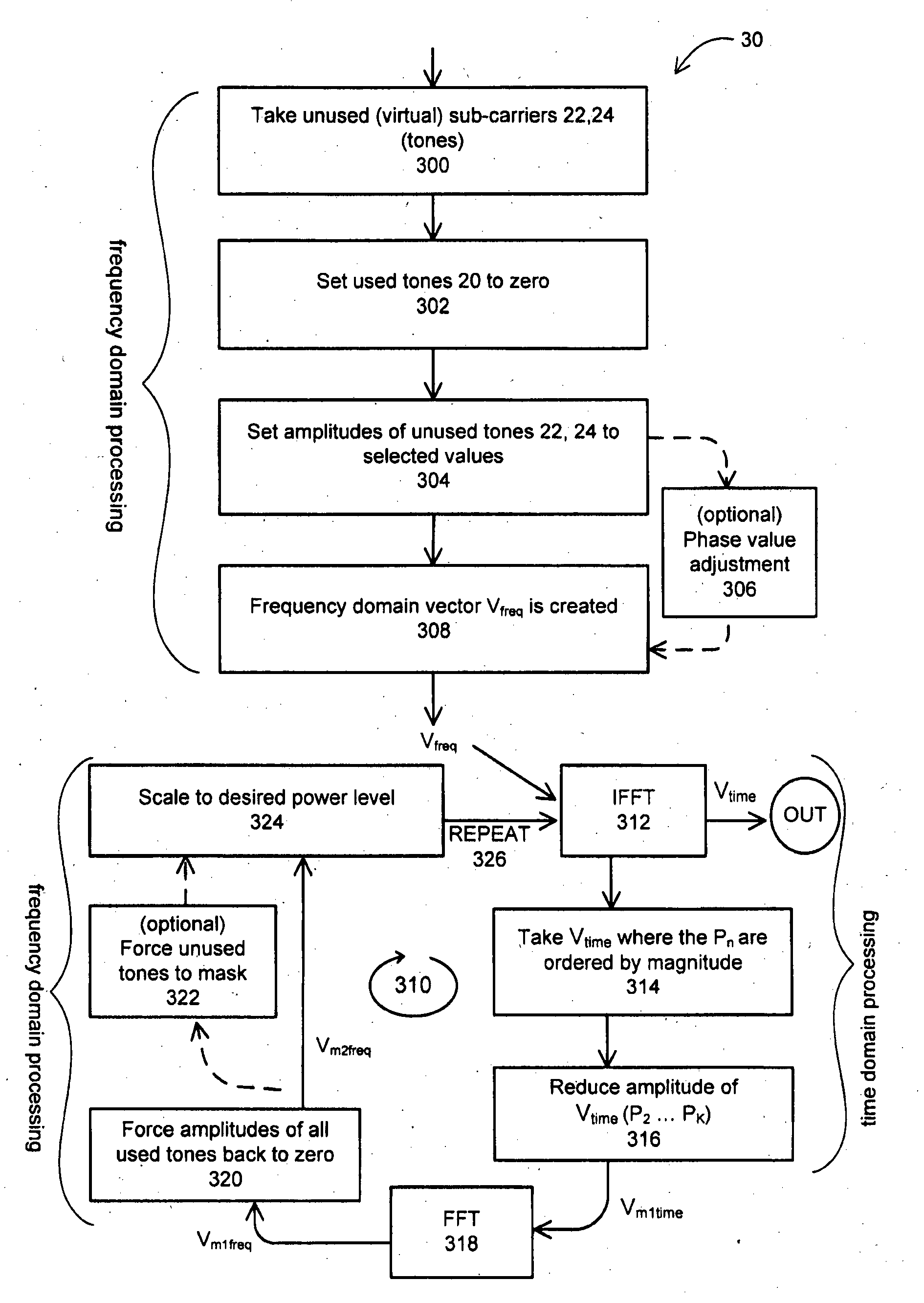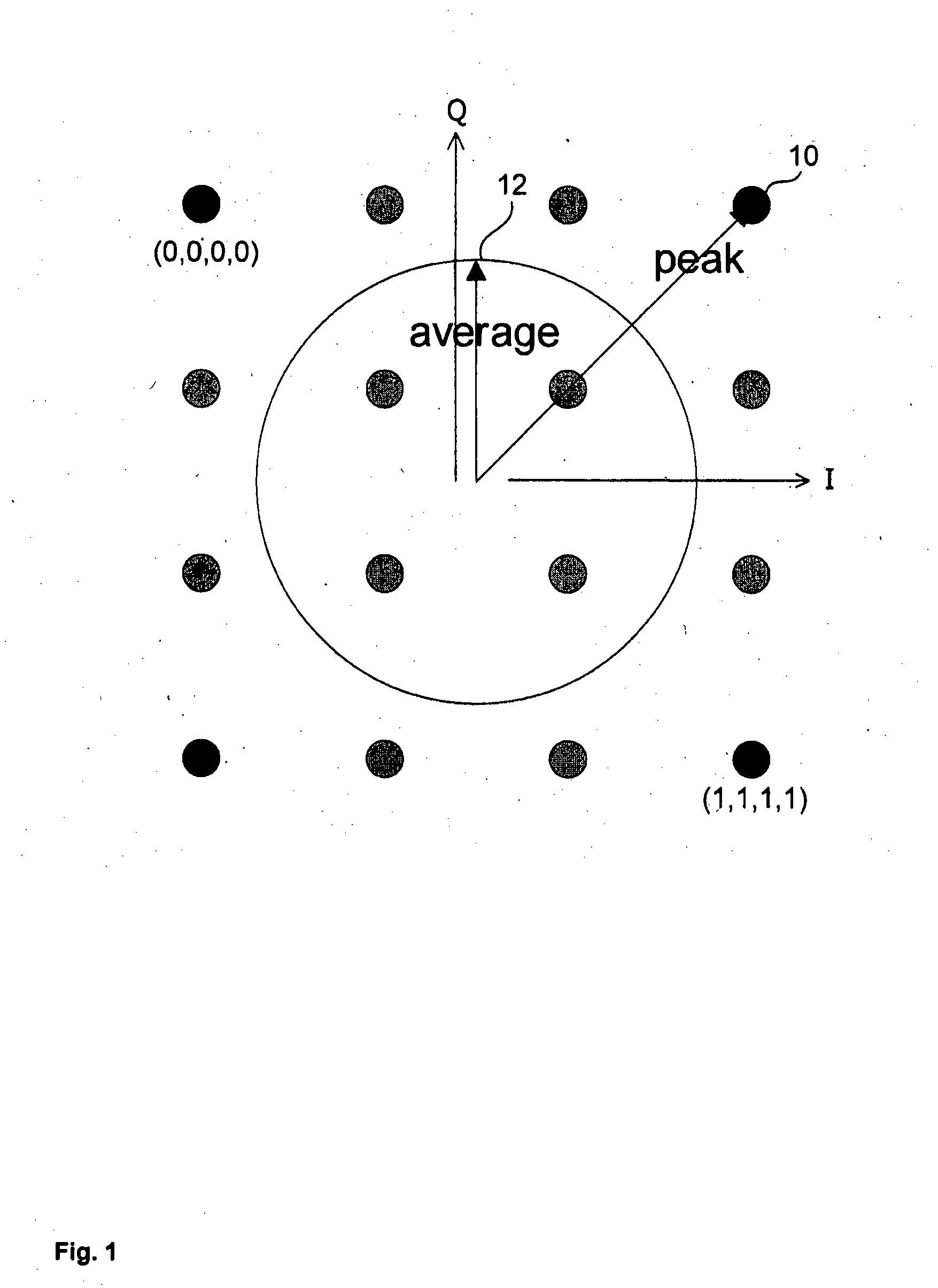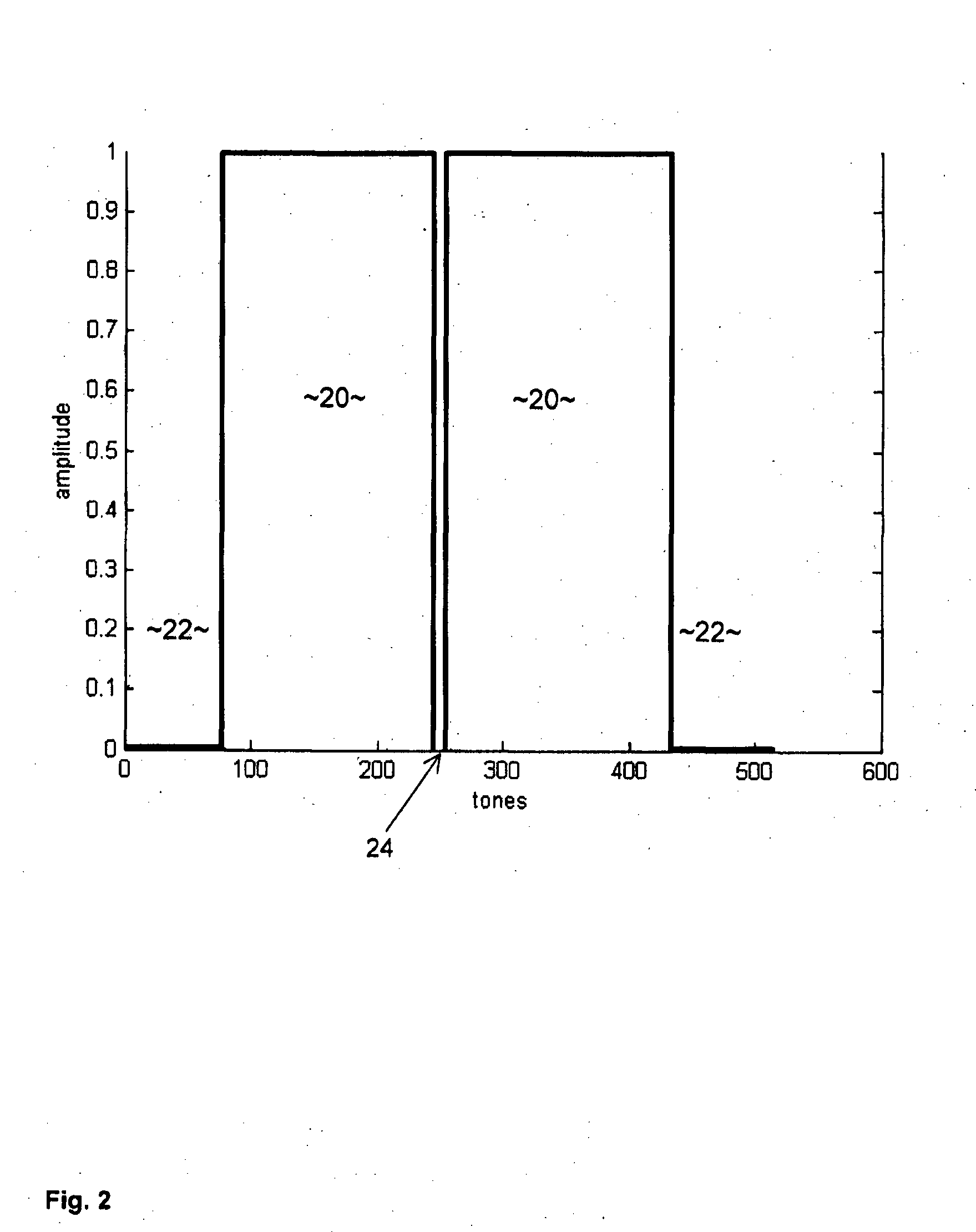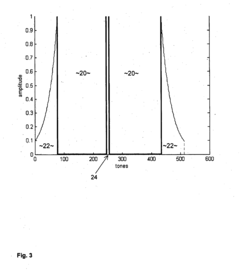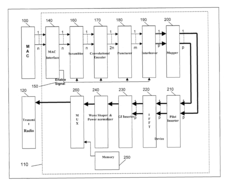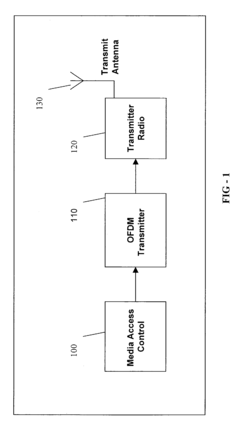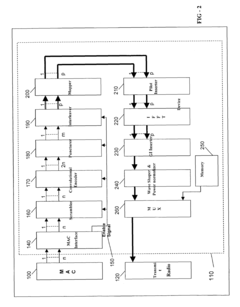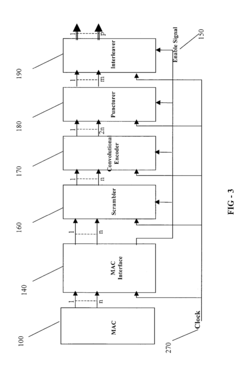Enhancing OFDM Performance with Turbo Coding Techniques
SEP 12, 20259 MIN READ
Generate Your Research Report Instantly with AI Agent
Patsnap Eureka helps you evaluate technical feasibility & market potential.
OFDM and Turbo Coding Evolution and Objectives
Orthogonal Frequency Division Multiplexing (OFDM) emerged in the 1960s as a digital multi-carrier modulation technique, evolving from Frequency Division Multiplexing (FDM). The initial concept was patented by Chang at Bell Labs in 1966, but practical implementation remained challenging until the integration of Fast Fourier Transform (FFT) algorithms in the 1970s. This breakthrough significantly reduced computational complexity, making OFDM commercially viable for various applications.
Turbo coding, introduced by Berrou, Glavieux, and Thitimajshima in 1993, revolutionized error correction by approaching Shannon's theoretical limit. These parallel concatenated convolutional codes with iterative decoding achieved unprecedented error performance, initially meeting skepticism before gaining widespread acceptance in telecommunications standards.
The convergence of these technologies represents a critical evolution in wireless communications. OFDM addresses multipath fading and inter-symbol interference challenges by dividing the channel into multiple orthogonal sub-carriers, while turbo coding provides robust error correction capabilities essential for maintaining signal integrity in challenging environments.
Current technological trends indicate a growing demand for higher data rates, improved spectral efficiency, and enhanced reliability in wireless communications. The integration of advanced turbo coding techniques with OFDM systems aims to optimize performance in next-generation networks, particularly in 5G and beyond, where requirements for low latency and high reliability are paramount.
The primary objectives of enhancing OFDM with turbo coding techniques include: improving bit error rate (BER) performance under varying channel conditions; increasing system throughput without additional bandwidth requirements; reducing computational complexity while maintaining performance gains; and developing adaptive coding schemes that respond dynamically to changing channel characteristics.
Research goals extend to optimizing the interleaver design in turbo-coded OFDM systems, as interleaver structure significantly impacts error correction capabilities. Additionally, there is focus on developing efficient decoding algorithms that balance performance with implementation complexity, particularly for resource-constrained devices.
The evolution trajectory suggests movement toward more sophisticated hybrid systems that combine turbo coding with other advanced techniques such as MIMO (Multiple-Input Multiple-Output) and adaptive modulation. These integrated approaches aim to push the boundaries of what's achievable in wireless communication performance, addressing the exponentially growing demand for data in modern digital ecosystems.
Turbo coding, introduced by Berrou, Glavieux, and Thitimajshima in 1993, revolutionized error correction by approaching Shannon's theoretical limit. These parallel concatenated convolutional codes with iterative decoding achieved unprecedented error performance, initially meeting skepticism before gaining widespread acceptance in telecommunications standards.
The convergence of these technologies represents a critical evolution in wireless communications. OFDM addresses multipath fading and inter-symbol interference challenges by dividing the channel into multiple orthogonal sub-carriers, while turbo coding provides robust error correction capabilities essential for maintaining signal integrity in challenging environments.
Current technological trends indicate a growing demand for higher data rates, improved spectral efficiency, and enhanced reliability in wireless communications. The integration of advanced turbo coding techniques with OFDM systems aims to optimize performance in next-generation networks, particularly in 5G and beyond, where requirements for low latency and high reliability are paramount.
The primary objectives of enhancing OFDM with turbo coding techniques include: improving bit error rate (BER) performance under varying channel conditions; increasing system throughput without additional bandwidth requirements; reducing computational complexity while maintaining performance gains; and developing adaptive coding schemes that respond dynamically to changing channel characteristics.
Research goals extend to optimizing the interleaver design in turbo-coded OFDM systems, as interleaver structure significantly impacts error correction capabilities. Additionally, there is focus on developing efficient decoding algorithms that balance performance with implementation complexity, particularly for resource-constrained devices.
The evolution trajectory suggests movement toward more sophisticated hybrid systems that combine turbo coding with other advanced techniques such as MIMO (Multiple-Input Multiple-Output) and adaptive modulation. These integrated approaches aim to push the boundaries of what's achievable in wireless communication performance, addressing the exponentially growing demand for data in modern digital ecosystems.
Market Demand for Enhanced Wireless Communication Systems
The wireless communication market is experiencing unprecedented growth, driven by the increasing demand for high-speed, reliable data transmission across various applications. The global wireless communication market was valued at $518.5 billion in 2022 and is projected to reach $2.1 trillion by 2030, growing at a CAGR of 19.8%. This substantial growth underscores the critical need for enhanced communication technologies like OFDM with turbo coding techniques.
5G and emerging 6G technologies represent key market drivers, with 5G subscriptions expected to reach 4.4 billion by 2027. These advanced networks require robust modulation schemes and error correction capabilities to deliver promised performance metrics. OFDM with turbo coding directly addresses these requirements by significantly improving spectral efficiency and error resilience in challenging wireless environments.
The Internet of Things (IoT) ecosystem presents another substantial market opportunity, with connected devices projected to exceed 25.4 billion by 2030. These devices operate in diverse environments with varying signal conditions, necessitating communication systems that can maintain reliability despite interference and signal degradation. Enhanced OFDM systems with turbo coding provide the error correction capabilities essential for maintaining connectivity in these challenging scenarios.
Automotive and transportation sectors are rapidly adopting wireless technologies for vehicle-to-everything (V2X) communications, advanced driver assistance systems, and autonomous driving capabilities. These applications demand ultra-reliable low-latency communications (URLLC) where even minimal data corruption can have serious consequences. The market for automotive wireless systems is expected to grow at 21.4% CAGR through 2028, creating significant demand for enhanced modulation and coding techniques.
Enterprise and industrial applications represent another growth segment, with Industry 4.0 initiatives driving adoption of wireless technologies in manufacturing, logistics, and process industries. These environments often feature electromagnetic interference, physical obstacles, and moving machinery that challenge conventional wireless systems. Enhanced OFDM with turbo coding provides the robustness needed for industrial deployment, addressing a market segment valued at $94.3 billion in 2022.
Consumer demand for high-definition streaming, cloud gaming, and immersive experiences like augmented and virtual reality is pushing bandwidth requirements to new heights. These applications require not only high throughput but also consistent quality of service that can only be delivered through advanced modulation and coding schemes. The consumer segment remains the largest market for enhanced wireless technologies, accounting for 58% of total market value.
5G and emerging 6G technologies represent key market drivers, with 5G subscriptions expected to reach 4.4 billion by 2027. These advanced networks require robust modulation schemes and error correction capabilities to deliver promised performance metrics. OFDM with turbo coding directly addresses these requirements by significantly improving spectral efficiency and error resilience in challenging wireless environments.
The Internet of Things (IoT) ecosystem presents another substantial market opportunity, with connected devices projected to exceed 25.4 billion by 2030. These devices operate in diverse environments with varying signal conditions, necessitating communication systems that can maintain reliability despite interference and signal degradation. Enhanced OFDM systems with turbo coding provide the error correction capabilities essential for maintaining connectivity in these challenging scenarios.
Automotive and transportation sectors are rapidly adopting wireless technologies for vehicle-to-everything (V2X) communications, advanced driver assistance systems, and autonomous driving capabilities. These applications demand ultra-reliable low-latency communications (URLLC) where even minimal data corruption can have serious consequences. The market for automotive wireless systems is expected to grow at 21.4% CAGR through 2028, creating significant demand for enhanced modulation and coding techniques.
Enterprise and industrial applications represent another growth segment, with Industry 4.0 initiatives driving adoption of wireless technologies in manufacturing, logistics, and process industries. These environments often feature electromagnetic interference, physical obstacles, and moving machinery that challenge conventional wireless systems. Enhanced OFDM with turbo coding provides the robustness needed for industrial deployment, addressing a market segment valued at $94.3 billion in 2022.
Consumer demand for high-definition streaming, cloud gaming, and immersive experiences like augmented and virtual reality is pushing bandwidth requirements to new heights. These applications require not only high throughput but also consistent quality of service that can only be delivered through advanced modulation and coding schemes. The consumer segment remains the largest market for enhanced wireless technologies, accounting for 58% of total market value.
Current OFDM-Turbo Integration Challenges
Despite the significant advancements in OFDM-Turbo coding integration, several critical challenges persist that impede optimal performance in modern communication systems. The primary challenge lies in computational complexity, as turbo coding algorithms require iterative decoding processes that demand substantial processing power and energy consumption. This becomes particularly problematic in resource-constrained devices such as IoT sensors and mobile terminals where battery life and processing capabilities are limited.
Latency issues present another significant obstacle, especially in time-sensitive applications like autonomous vehicles, industrial automation, and real-time video streaming. The iterative nature of turbo decoding introduces delays that may not meet the stringent timing requirements of these applications, creating a fundamental tension between error correction capability and processing speed.
Implementation complexity poses substantial challenges for hardware designers. The intricate architecture required for efficient turbo decoder implementation demands specialized hardware accelerators and optimized algorithms. This complexity increases silicon area, power consumption, and development costs, making it difficult to integrate into cost-sensitive consumer devices.
Channel estimation accuracy significantly impacts the performance of OFDM-Turbo systems. In rapidly changing channel conditions, such as high-mobility scenarios, maintaining precise channel state information becomes exceedingly difficult. Imperfect channel estimation leads to degraded turbo decoder performance, as the soft information fed into the decoder becomes less reliable.
Adaptability to varying channel conditions represents another major challenge. Communication systems must operate across diverse environments with fluctuating signal-to-noise ratios, interference levels, and multipath characteristics. Developing adaptive coding schemes that can dynamically adjust parameters based on channel conditions while maintaining backward compatibility with existing standards remains technically challenging.
Spectral efficiency trade-offs create additional complications. While turbo codes provide excellent error correction capabilities, they introduce redundancy that reduces overall spectral efficiency. Finding the optimal balance between error protection and data throughput continues to challenge system designers, particularly as data rate demands increase exponentially.
Energy efficiency concerns have become increasingly prominent as communication networks expand. The iterative decoding process of turbo codes consumes significant energy, which conflicts with the growing emphasis on sustainable and energy-efficient communication technologies. This challenge is particularly acute in battery-powered devices and large-scale network infrastructure where energy consumption directly impacts operational costs.
Latency issues present another significant obstacle, especially in time-sensitive applications like autonomous vehicles, industrial automation, and real-time video streaming. The iterative nature of turbo decoding introduces delays that may not meet the stringent timing requirements of these applications, creating a fundamental tension between error correction capability and processing speed.
Implementation complexity poses substantial challenges for hardware designers. The intricate architecture required for efficient turbo decoder implementation demands specialized hardware accelerators and optimized algorithms. This complexity increases silicon area, power consumption, and development costs, making it difficult to integrate into cost-sensitive consumer devices.
Channel estimation accuracy significantly impacts the performance of OFDM-Turbo systems. In rapidly changing channel conditions, such as high-mobility scenarios, maintaining precise channel state information becomes exceedingly difficult. Imperfect channel estimation leads to degraded turbo decoder performance, as the soft information fed into the decoder becomes less reliable.
Adaptability to varying channel conditions represents another major challenge. Communication systems must operate across diverse environments with fluctuating signal-to-noise ratios, interference levels, and multipath characteristics. Developing adaptive coding schemes that can dynamically adjust parameters based on channel conditions while maintaining backward compatibility with existing standards remains technically challenging.
Spectral efficiency trade-offs create additional complications. While turbo codes provide excellent error correction capabilities, they introduce redundancy that reduces overall spectral efficiency. Finding the optimal balance between error protection and data throughput continues to challenge system designers, particularly as data rate demands increase exponentially.
Energy efficiency concerns have become increasingly prominent as communication networks expand. The iterative decoding process of turbo codes consumes significant energy, which conflicts with the growing emphasis on sustainable and energy-efficient communication technologies. This challenge is particularly acute in battery-powered devices and large-scale network infrastructure where energy consumption directly impacts operational costs.
Existing OFDM-Turbo Implementation Approaches
01 OFDM-Turbo Coding System Performance Enhancement
Various techniques are employed to enhance the performance of OFDM systems with turbo coding. These include optimized interleaver designs, adaptive modulation schemes, and improved decoding algorithms. These enhancements result in better bit error rate (BER) performance, increased throughput, and improved reliability in wireless communication systems, particularly in challenging channel conditions.- Performance enhancement techniques for OFDM with Turbo Coding: Various techniques can be employed to enhance the performance of OFDM systems using turbo coding. These include optimized interleaver designs, improved decoding algorithms, and adaptive modulation schemes. By implementing these enhancements, communication systems can achieve better bit error rate performance, increased throughput, and improved reliability in challenging channel conditions.
- OFDM-Turbo coding for wireless communication systems: The combination of OFDM with turbo coding provides significant advantages for wireless communication systems. This approach offers robust performance in multipath environments while maintaining high spectral efficiency. The integration of these technologies is particularly beneficial for mobile networks, broadband wireless access, and other applications requiring reliable high-speed data transmission under varying channel conditions.
- Error correction and channel estimation in OFDM-Turbo systems: Advanced error correction mechanisms and channel estimation techniques are crucial for optimizing OFDM systems with turbo coding. These methods include iterative decoding processes, soft-decision algorithms, and adaptive channel estimation that can respond to changing transmission environments. Such approaches significantly reduce bit error rates and improve overall system reliability, particularly in environments with high interference or fading.
- Implementation architectures for OFDM-Turbo coded systems: Various hardware and software architectures have been developed to efficiently implement OFDM systems with turbo coding. These designs focus on optimizing computational complexity, reducing power consumption, and enabling real-time processing. Implementation considerations include parallel processing structures, memory management for interleavers, and hardware-friendly algorithms that maintain performance while reducing resource requirements.
- MIMO-OFDM systems with turbo coding: Multiple-Input Multiple-Output (MIMO) technology combined with OFDM and turbo coding creates highly efficient communication systems with enhanced spectral efficiency and reliability. This integration leverages spatial diversity to further improve performance beyond what is possible with OFDM and turbo coding alone. Such systems demonstrate superior performance in terms of data rate, coverage, and resistance to interference, making them suitable for advanced wireless applications.
02 Error Correction and Channel Coding in OFDM Systems
Turbo coding provides powerful error correction capabilities in OFDM systems by using parallel concatenated convolutional codes with iterative decoding. These systems implement various interleaving techniques and puncturing patterns to achieve different code rates. The combination of OFDM's robustness against multipath fading and turbo coding's error correction capability significantly improves system performance in terms of bit error rate and throughput.Expand Specific Solutions03 MIMO-OFDM Systems with Turbo Coding
Multiple-Input Multiple-Output (MIMO) technology combined with OFDM and turbo coding creates highly efficient communication systems. These systems utilize spatial diversity and multiplexing to improve spectral efficiency and reliability. Advanced signal processing techniques are employed to mitigate interference and enhance channel estimation, resulting in superior performance compared to single-antenna systems, especially in high-mobility scenarios.Expand Specific Solutions04 Adaptive Modulation and Coding for OFDM Systems
Adaptive modulation and coding schemes dynamically adjust transmission parameters based on channel conditions in OFDM systems with turbo coding. These systems monitor channel quality indicators and select appropriate modulation orders and code rates to optimize performance. This approach balances throughput and reliability, providing robust performance across varying channel conditions while efficiently utilizing available bandwidth.Expand Specific Solutions05 Implementation and Hardware Architecture for OFDM-Turbo Systems
Efficient hardware architectures for implementing OFDM systems with turbo coding focus on reducing complexity while maintaining performance. These implementations include optimized turbo decoder designs, parallel processing structures, and memory-efficient interleavers. Various hardware acceleration techniques and FPGA/ASIC implementations enable real-time processing with reduced latency and power consumption, making these systems suitable for practical wireless communication applications.Expand Specific Solutions
Key Industry Players in Wireless Communication Technologies
The OFDM with Turbo Coding technology market is currently in a growth phase, with an expanding market size driven by increasing demand for high-performance wireless communications. The competitive landscape features established telecommunications giants like Samsung, Qualcomm, Huawei, and LG Electronics leading commercial implementation, while academic institutions such as University of Electronic Science & Technology of China and Beijing University of Posts & Telecommunications contribute significant research advancements. The technology has reached moderate maturity in 4G applications but continues evolving for 5G implementation, with companies like NTT Docomo and ZTE focusing on enhancing spectral efficiency and error correction capabilities. Collaboration between industry leaders and research institutions is accelerating development, with Qualcomm and Samsung holding substantial patent portfolios in this domain.
Samsung Electronics Co., Ltd.
Technical Solution: Samsung has developed a comprehensive turbo coding solution for OFDM systems called "TurboSync" that enhances wireless communication reliability and throughput. Their approach implements an 8-state parallel concatenated convolutional code with optimized constituent encoders specifically designed for OFDM's sensitivity to burst errors. Samsung's implementation features a novel bit-interleaving pattern that distributes coded bits across both frequency and time domains, effectively exploiting the diversity offered by OFDM subcarriers. Their decoder architecture employs a modified BCJR algorithm with early stopping criteria, reducing average decoding iterations by approximately 40% while maintaining error performance within 0.1dB of the theoretical limit. Samsung has integrated adaptive modulation and coding with their turbo codes, allowing dynamic selection of code rates between 1/5 and 9/10 based on channel state information. This technology has been implemented in Samsung's wireless chipsets, demonstrating bit error rates below 10^-5 at SNRs approximately 0.5dB from capacity in typical urban channel models.
Strengths: Excellent error correction performance in multipath environments; efficient hardware implementation with reduced power consumption; seamless integration with adaptive modulation schemes. Weaknesses: Higher computational complexity than LDPC alternatives; increased latency for iterative decoding process; requires significant memory resources for interleaver storage.
QUALCOMM, Inc.
Technical Solution: Qualcomm has developed advanced turbo coding implementations for OFDM systems that significantly enhance wireless communication performance. Their approach combines parallel concatenated convolutional codes with sophisticated interleaving patterns specifically optimized for OFDM's multicarrier nature. Qualcomm's implementation includes adaptive code rate selection based on channel conditions, with rates ranging from 1/3 to 5/6 depending on signal quality measurements. Their turbo decoder architecture employs the Max-Log-MAP algorithm with early termination capabilities, reducing decoding latency by up to 50% compared to conventional approaches. Qualcomm has integrated these turbo coding techniques into their modem chipsets, achieving bit error rates below 10^-6 at SNRs approximately 0.7dB from Shannon limit. Their solution also incorporates hybrid ARQ mechanisms that work synergistically with turbo codes to provide robust performance in fading channels typical in mobile environments.
Strengths: Superior error correction performance approaching theoretical limits; highly optimized hardware implementation with low power consumption; excellent performance in mobile fading channels. Weaknesses: Higher computational complexity compared to simpler coding schemes; increased decoding latency for very low SNR conditions; requires more silicon area in chipset implementations.
Critical Patents and Research in OFDM-Turbo Integration
Orthogonal frequency division multiplexing (OFDM)
PatentActiveUS20120257690A1
Innovation
- A method that transforms digital data symbols into the time domain, generates cancellation vectors with zero values in specific sub-carriers to reduce PAPR, using a basis vector that maximizes the difference between its elements, and iteratively processes these vectors to minimize peak power, allowing for reduced PAPR without distorting the signal.
Orthogonal frequency division multiplexing transmitter system and VLSI implementation thereof
PatentActiveUS7379417B2
Innovation
- An improved OFDM transmitter system with a VLSI implementation that uses a single clock for all blocks, employing a parallel scrambler, convolutional encoder, shift register-based interleaver, and combined wave shaping and power normalization to reduce latency and gate count, while supporting multi-rate data transmission.
Spectrum Efficiency and Regulatory Considerations
Spectrum efficiency represents a critical consideration in the implementation of OFDM systems enhanced with turbo coding techniques. The combination of these technologies must operate within strictly regulated frequency bands while maximizing data throughput per unit of bandwidth. Current regulatory frameworks worldwide have established specific spectral masks and out-of-band emission limits that OFDM-turbo coded systems must adhere to, particularly in wireless communication standards such as 5G, LTE, and Wi-Fi.
The spectral efficiency of turbo-coded OFDM systems is typically measured in bits per second per Hertz (bits/s/Hz), with modern implementations achieving 3-6 bits/s/Hz in favorable channel conditions. This efficiency is significantly enhanced through the error-correction capabilities of turbo codes, which allow for reliable communication at lower signal-to-noise ratios, thereby enabling higher-order modulation schemes without compromising transmission reliability.
Regulatory bodies including the FCC (United States), ETSI (Europe), and similar organizations in Asia have established frameworks that influence the deployment of turbo-coded OFDM systems. These regulations address issues such as frequency allocation, power spectral density limits, and adjacent channel interference. The dynamic spectrum access capabilities of advanced OFDM implementations must be designed to comply with these regulatory constraints while maintaining optimal performance.
Recent developments in cognitive radio technologies have introduced additional considerations for spectrum-efficient turbo-coded OFDM systems. These systems can adaptively sense and utilize available spectrum, adjusting parameters such as coding rate, modulation order, and power allocation based on real-time channel conditions and regulatory requirements. This adaptive approach maximizes spectrum utilization while ensuring compliance with regional regulatory frameworks.
The trade-off between bandwidth efficiency and power efficiency presents another important consideration. While turbo coding significantly improves the bit error rate performance at a given signal-to-noise ratio, it introduces computational complexity and potential latency. System designers must balance these factors against regulatory requirements for specific applications, particularly in power-limited scenarios such as mobile devices and IoT implementations.
Looking forward, emerging regulatory frameworks for next-generation wireless systems are increasingly focused on spectrum sharing models rather than exclusive licensing. This shift presents both opportunities and challenges for turbo-coded OFDM systems, which must incorporate more sophisticated interference management techniques while maintaining spectral efficiency. The development of advanced spectrum sensing algorithms and dynamic resource allocation mechanisms will be crucial for maximizing the benefits of turbo coding in OFDM systems within these evolving regulatory environments.
The spectral efficiency of turbo-coded OFDM systems is typically measured in bits per second per Hertz (bits/s/Hz), with modern implementations achieving 3-6 bits/s/Hz in favorable channel conditions. This efficiency is significantly enhanced through the error-correction capabilities of turbo codes, which allow for reliable communication at lower signal-to-noise ratios, thereby enabling higher-order modulation schemes without compromising transmission reliability.
Regulatory bodies including the FCC (United States), ETSI (Europe), and similar organizations in Asia have established frameworks that influence the deployment of turbo-coded OFDM systems. These regulations address issues such as frequency allocation, power spectral density limits, and adjacent channel interference. The dynamic spectrum access capabilities of advanced OFDM implementations must be designed to comply with these regulatory constraints while maintaining optimal performance.
Recent developments in cognitive radio technologies have introduced additional considerations for spectrum-efficient turbo-coded OFDM systems. These systems can adaptively sense and utilize available spectrum, adjusting parameters such as coding rate, modulation order, and power allocation based on real-time channel conditions and regulatory requirements. This adaptive approach maximizes spectrum utilization while ensuring compliance with regional regulatory frameworks.
The trade-off between bandwidth efficiency and power efficiency presents another important consideration. While turbo coding significantly improves the bit error rate performance at a given signal-to-noise ratio, it introduces computational complexity and potential latency. System designers must balance these factors against regulatory requirements for specific applications, particularly in power-limited scenarios such as mobile devices and IoT implementations.
Looking forward, emerging regulatory frameworks for next-generation wireless systems are increasingly focused on spectrum sharing models rather than exclusive licensing. This shift presents both opportunities and challenges for turbo-coded OFDM systems, which must incorporate more sophisticated interference management techniques while maintaining spectral efficiency. The development of advanced spectrum sensing algorithms and dynamic resource allocation mechanisms will be crucial for maximizing the benefits of turbo coding in OFDM systems within these evolving regulatory environments.
Hardware Implementation and Computational Complexity Analysis
The hardware implementation of turbo coding techniques in OFDM systems presents significant challenges due to the computational complexity and resource requirements. Current FPGA and ASIC implementations typically utilize parallel processing architectures to handle the iterative nature of turbo decoding. Modern designs employ multiple processing elements working concurrently on different segments of the received data, with high-end implementations featuring up to 64 parallel decoding units to achieve throughput rates exceeding 1 Gbps.
Memory management represents a critical bottleneck in hardware implementations. The interleaving patterns essential to turbo codes require substantial memory resources for storing intermediate values between iterations. Recent advancements have introduced memory-efficient architectures that reduce the required storage by up to 40% through innovative addressing schemes and on-the-fly calculation of certain metrics.
Computational complexity analysis reveals that turbo decoding operations constitute approximately 70-80% of the total processing load in turbo-coded OFDM systems. The Log-MAP algorithm, widely adopted for its performance-complexity trade-off, requires approximately 8N multiply-accumulate operations per iteration for a block size of N bits. For a typical 5G application with 1024-bit blocks and 8 iterations, this translates to over 65,000 operations per decoded block.
Power consumption remains a significant concern, particularly for mobile applications. Current 7nm process implementations of turbo decoders for OFDM systems consume between 150-300 mW when operating at full throughput. Energy-efficient designs have emerged that implement dynamic iteration control, terminating the decoding process early when sufficient reliability is achieved, reducing power consumption by up to 35% with minimal performance degradation.
Implementation complexity scales non-linearly with the number of iterations and code rate. Higher code rates generally require more iterations to achieve the same error performance, increasing computational demands. Analysis shows that doubling the code rate from 1/3 to 2/3 increases computational complexity by approximately 40% to maintain equivalent bit error rate performance in typical channel conditions.
Recent hardware optimizations have focused on flexible architectures capable of supporting multiple coding schemes and rates, allowing dynamic adaptation to channel conditions. These configurable implementations typically incur a 15-20% overhead in hardware resources compared to fixed-function designs but provide significant advantages in system adaptability and performance across varying channel conditions.
Memory management represents a critical bottleneck in hardware implementations. The interleaving patterns essential to turbo codes require substantial memory resources for storing intermediate values between iterations. Recent advancements have introduced memory-efficient architectures that reduce the required storage by up to 40% through innovative addressing schemes and on-the-fly calculation of certain metrics.
Computational complexity analysis reveals that turbo decoding operations constitute approximately 70-80% of the total processing load in turbo-coded OFDM systems. The Log-MAP algorithm, widely adopted for its performance-complexity trade-off, requires approximately 8N multiply-accumulate operations per iteration for a block size of N bits. For a typical 5G application with 1024-bit blocks and 8 iterations, this translates to over 65,000 operations per decoded block.
Power consumption remains a significant concern, particularly for mobile applications. Current 7nm process implementations of turbo decoders for OFDM systems consume between 150-300 mW when operating at full throughput. Energy-efficient designs have emerged that implement dynamic iteration control, terminating the decoding process early when sufficient reliability is achieved, reducing power consumption by up to 35% with minimal performance degradation.
Implementation complexity scales non-linearly with the number of iterations and code rate. Higher code rates generally require more iterations to achieve the same error performance, increasing computational demands. Analysis shows that doubling the code rate from 1/3 to 2/3 increases computational complexity by approximately 40% to maintain equivalent bit error rate performance in typical channel conditions.
Recent hardware optimizations have focused on flexible architectures capable of supporting multiple coding schemes and rates, allowing dynamic adaptation to channel conditions. These configurable implementations typically incur a 15-20% overhead in hardware resources compared to fixed-function designs but provide significant advantages in system adaptability and performance across varying channel conditions.
Unlock deeper insights with Patsnap Eureka Quick Research — get a full tech report to explore trends and direct your research. Try now!
Generate Your Research Report Instantly with AI Agent
Supercharge your innovation with Patsnap Eureka AI Agent Platform!
